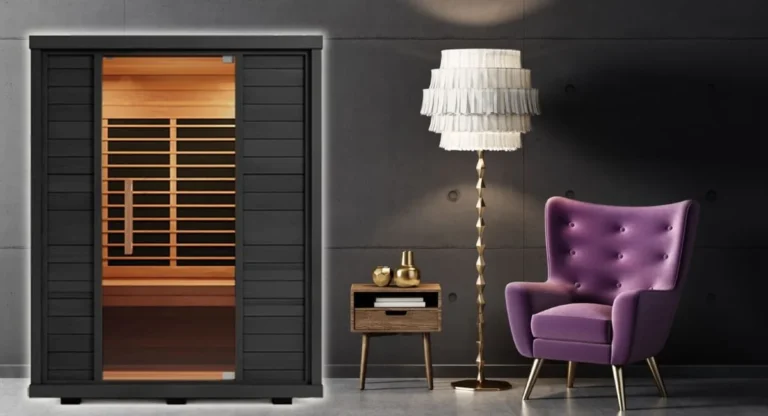How to Use a Sauna: Essential Tips for Every Experience Level

Did you know that Finns, the sauna masters themselves, spend an average of 3 hours per week in saunas? That’s some serious heat time! But don’t worry; we’re not expecting you to jump into marathon sweat sessions just yet.
Key Takeaways
- Prep: Shower, hydrate, and ditch the jewelry
- In the sauna: Start with short sessions, listen to your body, and stay hydrated
- Positioning: Choose lower benches for beginners, middle spots for balanced heat
- Post-sauna: Cool down gradually and rehydrate
- Safety first: Avoid alcohol, know your limits, and consult a doctor if needed
- Customize: Tailor your sauna experience to your health and wellness goals
Whether you’re a sauna beginner or looking to level up your steam sessions, this guide will walk you through everything you need to know about how to use a sauna like a pro.
Let’s start with the basics and work our way up to sauna nirvana.
| Medical Disclaimer The information provided in this article is for educational purposes only and is not intended as medical advice. Always consult with a qualified healthcare professional before starting any new health regimen, including the use of saunas. The author and publisher of this content are not responsible for any adverse effects or consequences resulting from the use of any suggestions, preparations, or procedures described in this article. |
Table of Contents
What is a Sauna and its Types?
Before we learn about how to use a sauna, let’s quickly understand what a sauna is. A sauna is basically a room or small building designed to make you sweat buckets – in the best way possible! It’s like a personal sweat lodge that can work wonders for your body and mind.
Saunas aren’t new. Sauna therapy has been an integral part of Finnish culture for over 2000 years, with over 2 million saunas in Finland for its population of 5 million.
Here’s a quick rundown of the main sauna types you might encounter:
1. Traditional Finnish Sauna or Dry Sauna
The OG of saunas. A dry sauna uses heated rocks and a sauna stove to create dry heat, usually cranking up to a toasty 160-190°F. You can splash water on the rocks for a bit of steam action.

2. Infrared Sauna
The new kid on the block. These use infrared lamps to heat your body directly, without warming up the air around you. They’re usually a bit cooler, around 120-140°F.
Related: Top Home Infrared Saunas
3. Steam Room
Think tropical rainforest vibes. These are super humid and usually hover around 110-120°F. Great for clearing out those sinuses! Turkish-style saunas are a prime example of steam rooms.
Each type has its own unique health benefits, so it’s worth trying them all to see which one floats your boat. Personally, I’m a fan of the traditional Finnish sauna- there’s something about that dry heat that just hits differently!
What to Expect: A First-Timer’s Guide to Sauna Sessions
First time hitting the sauna? Let’s walk through what your body’s going to experience.
That initial blast of heat might feel intense for first time sauna users– like opening an oven door right in your face! But don’t worry, that’s totally normal. Your body temperature will rise and you’ll start sweating within 3-5 minutes as it kicks into cooling mode.
Here’s what catches most newbies off guard:
- Your heart rate will increase (like during a light jog)
- You might feel a tingling sensation on your skin
- Breathing might feel different in the hot air
- Your face will flush (hello, natural blush!)
What are the biggest rookie mistakes?
- Jumping straight to the top bench (that’s where it’s hottest, folks!)
- Wearing too many clothes (less is more)
- Trying to tough it out when your body’s saying “nope!”
Remember, even sauna veterans started somewhere, so take it easy.
Smart Sauna Seating: Where to Position Yourself
Ever wondered why those benches are at different heights? It’s not just fancy design! Heat rises, making the top bench about 15-20°F hotter than the lower ones. Here’s your position playbook:
For Beginners:
- Start on the lower sauna bench where temps are milder
- Keep your feet at bench level (not on the floor) to maintain even heat exposure
- Stay about 3-4 feet away from the heat source
As you build tolerance, you can graduate to higher benches. Think of it like leveling up in a game – each session makes you a bit more heat-savvy!
Pro tip: That corner spot might look cozy, but middle positions usually offer the most balanced heat distribution. And if you’re feeling too hot? Just slide down to a lower bench – no shame in that game!

How to Use a Sauna: Best Practices for a Beneficial and Safe Sauna Experience
1. How to Prepare for a Sauna Session
Before stepping into the sauna, proper preparation is key.
- Start by choosing a time when you’re not rushed; whether it’s morning or evening, make sure you can fully relax.
- Take a warm shower to open your pores and cleanse your skin.
- Hydrate well, drinking 16-20 oz of water in an hour or two before your session.
- Remove all jewelry; metal can get uncomfortably hot in there.
- If you have long hair, tie it back to prevent excessive neck sweating.
- Wear light, breathable clothing, and bring a towel to sit on.
- Remember to bring a bathing suit if using public saunas.
- If you’re using a traditional sauna, gather essentials like a bucket, ladle, and whisk.
- Finally, set a timer to track how long you stay in the sauna.
Related: Benefits of Sauna in the Morning
2. How to Use the Sauna
A. Start Low and Slow
When you first enter, find a comfortable spot to sit or lie down. Take deep breaths and let the warmth envelop you. For beginners, start with just 5-10 minutes at a lower sauna temperature, around 150°F. As your body adapts, gradually increase both duration and heat.
I remember my first sauna experience- the initial heat felt intense, but as I relaxed and focused on my breathing, it became incredibly soothing. Starting slow allowed me to build up my tolerance over time.
B. Sauna Duration and Frequency Guidelines
Different types of saunas operate at varying temperatures, which affects recommended session lengths and frequency:
Traditional Finnish Sauna (160-190°F)
- First-time sauna users: 5-10 minutes
- Regular sauna use: Up to 15-20 minutes per session
- Maximum recommended duration: 30 minutes
- Recommended frequency: 2-3 times per week for beginners, building up to 3-4 times weekly for experienced users
Related: How Often Should You Sauna?
Infrared Sauna (120-140°F)
- Beginners: 10-15 minutes
- Experienced users: Up to 20-30 minutes
- Maximum recommended duration: 45 minutes
- Recommended frequency: Can be used 3-4 times per week safely, some users may gradually increase to daily sauna bathing
Related: How Often Should You Use an Infrared Sauna?
Steam Room (110-120°F)
- First-time users: 10-15 minutes
- Regular users: Up to 20 minutes
- Maximum recommended duration: 30 minutes
- Recommended frequency: 2-3 times per week, with at least one day between sessions
Important Factors Affecting Duration and Frequency:
- Higher temperatures require shorter sessions
- Lower bench positions allow longer sessions due to lower heat exposure
- Medical conditions may require shorter sessions or temperature adjustments
- Hydration levels impact safe duration limits
- Personal heat tolerance varies significantly
- Recovery time between sessions should be considered
- Overall health and fitness level affect safe frequency
Note: Consult your healthcare provider for personalized recommendations.
C. Listen to Your Body
Pay close attention to how you feel. If you experience any discomfort, headache, nausea, or dizziness, it’s time to exit.
Some people may experience fatigue after sauna sessions – if you find yourself feeling tired after sauna use, understand that this is a common reaction with specific physiological causes.
Take sauna session breaks as needed to cool down and rehydrate. You can splash some water on your face and chest to help regulate your temperature.
A sauna expert once told me, “It’s not about enduring the heat, but finding your personal comfort zone.” This advice has stuck with me, reminding me to enjoy the experience rather than push my limits unnecessarily.

D. Stay Hydrated
Drinking plenty of water before, during, and after your sauna session is crucial. Consider coconut water or an electrolyte drink to replenish minerals lost through sweating. Avoid alcohol, caffeine, and sugary drinks, as these can lead to dehydration.
E. Sauna Etiquette in Public Saunas
In public saunas like a gym sauna, respect others and follow these gym sauna etiquette:
- Shower before entering
- Sit on a towel
- Keep noise to a minimum
- Respect personal space
- Ask before adding water to rocks
- Leave strong scents and phones outside
Remember, the sauna is a shared relaxation space. By following these simple rules, everyone can enjoy a peaceful experience.
F. Using Sauna Infusions
Sauna infusions enhance your experience by adding aromatherapy benefits when water is poured over hot sauna rocks. Mix 2-3 drops of essential oil per ladle of water and pour slowly over the rocks to create gentle steam.
Common infusions include eucalyptus for breathing, pine for a woodsy-scented sauna atmosphere, and lavender for relaxation. Wait 3-5 minutes between applications.
Safety Precautions:
- Use only pure essential oils meant for sauna infusions
- Check if others in public saunas are comfortable with infusions
- Avoid citrus oils as they can irritate skin
- Stop if you experience any discomfort
Pro Tip: Start with minimal amounts to test your sensitivity to different infusions. Too much steam can make breathing uncomfortable and overheat the sauna rocks.
Must Read:
Best Essential Oils for Sauna
The Top Sauna Accessories in 2025
3. Post-Sauna Care
After your sauna bathing session, take a cool shower or a cool bath to rinse off sweat and close your pores. Then, rest for 10-20 minutes to allow your heart rate to return to normal. Continue to hydrate during this time.
Sauna Safety Tips & Necessary Precautions
Safety first, sauna enthusiasts! Improper use of a sauna can be dangerous. Here are some golden sauna safety rules to live by:
- Whether in private saunas or public bathhouses, never lock the door, and avoid using the sauna under the influence of alcohol or drugs.
- If you’re new to saunas, bring a friend along for safety.
- If you have any medical conditions or take medications, consult your doctor before using a sauna.
- Pregnant? Best to steer clear until you get the all-clear from your healthcare provider.
- Avoid exercising or stretching in the sauna, as this can lead to injury.
- Don’t eat a heavy meal for at least two hours before your session.
- Always sit on a towel to prevent burns from hot benches.
- Start with short sessions at lower temperatures, gradually working your way up. Listen to your body and exit immediately if you feel unwell.
- Limit your sessions to 30 minutes or less, especially when you’re just starting out.
Related: What time to use a sauna after dinner?
Remember, the best way to sauna is the way that feels right for your body. Whether you prefer to sit upright or lie down, the key is to relax and enjoy the experience.
Some people like to add a bit of fun by trying the Finnish tradition of ‘Loyly’- throwing water on hot rocks to create steam. Just be careful not to overdo it!
By following these guidelines, you’ll be well on your way to enjoying safe and beneficial sauna sessions. The combination of heat, relaxation, and proper care can lead to a truly rejuvenating experience.

How to Use a Sauna for Specific Health and Wellness Goals
The beauty of saunas is that you can tailor your experience to your specific needs and health goals. Let’s break it down:
For Relaxation
Want to chill out? Try these:
- Lower the temperature a bit (around 150°F is nice)
- Bring some calming tunes or a meditation app
- Focus on deep, slow breathing
- Sauna Duration: 15-20 minutes per sauna bathing session
- Sauna Frequency: 2-3 sauna visits per week is ideal for stress relief
For Pain Relief
Aches and pains got you down? Here’s the ticket:
- Crank up the heat a little (170°F if you can handle it)
- Target problem areas with a warm, damp towel
- Follow up with some gentle stretching
- Start with 10-15 minutes per session
- 3-4 times weekly for chronic pain management
Related: Sauna and Back Pain Relief
For Detoxification
Ready to sweat it out? Let’s do this:
- Go for higher temperatures (180°F if you’re brave)
- Alternate between sauna and cool showers
- Hydrate with water and herbal teas
- Build up to 20-25 minutes per session
- Daily sauna bathing for 1-2 weeks for intensive detox, then maintain with 2-3 times weekly
For Weight Loss
Looking to burn some calories? Try this approach:
- Aim for longer sessions (up to 30 minutes if you’re comfortable)
- Pair with a balanced diet and regular exercise
- Stay super hydrated before, during, and after
- 20-30 minutes per session
- 3-4 sauna sessions per week
Learn more about Saunas and weight loss.
For Athletic Performance
Athletes, listen up:
- Use the sauna after workouts to aid recovery
- Try contrast therapy or intermittent sauna use– alternate between a hot sauna and a cold shower / ice bath
- Keep sessions shorter (10-15 minutes) to avoid dehydration
- 2-3 times per week, always after training
For Skin Health
Want that sauna glow? Here’s how:
- Stick to moderate temps (around 150°F)
- Exfoliate gently before your session
- Apply a hydrating mask or serum after cooling down
- 15-20 minutes per session
- 1-2 weekly sauna visits for maintenance, 2-3 for intensive skin care
Interestingly, the benefits of saunas might extend to digestive health – Learn how sauna sessions could potentially reduce bloating.
Remember: These are general guidelines for regular sauna use. Always listen to your body and adjust frequency and duration based on your personal comfort and health status.
Conclusion: Enjoy Your Sauna!
Well, folks, we’ve steamed through the ins and outs of how to use a sauna like a pro. From preparing properly to customizing your experience for specific health goals, you’re now armed with all the knowledge you need to make the most of your sauna sessions.
Remember, the key to a great sauna experience is listening to your body, staying hydrated, and finding what works best for you. Whether you’re in it for the relaxation, the health benefits, or just because it feels darn good, there’s no wrong way to sauna (as long as you’re being safe, of course).
So go forth and sweat, my friends! And who knows? Maybe one day, you’ll be giving the Finns a run for their money in the sauna stamina department. Until then, enjoy the journey and the post-sauna glow. Happy sweating!
FAQs About How To Use A Sauna
Can I use public bathhouses and communal baths in the same way as private saunas?
Public bathhouses and private saunas follow similar basic guidelines – shower first, sit on a towel, and follow duration limits. However, public facilities require extra etiquette like wearing bathing suits, keeping noise down, and respecting shared spaces.
What distinguishes different sauna types?
Different sauna types are distinguished by their heating methods and temperatures. Traditional saunas heat rooms to 160-190°F with dry heat and wood-lined walls. Infrared saunas use lamps for gentler direct body heating at 120-140°F. Steam rooms provide humid heat at 110-120°F.
Are home saunas safe for children?
Home saunas are safe for children with proper supervision and precautions. Children need shorter sessions than adults, lower temperatures, and pediatrician approval before use. Parents must monitor their children closely during sauna sessions and ensure proper hydration.
Should I bring a bathrobe and bathing suit to the sauna?
You should bring both a bathrobe and bathing suit to public saunas. The bathrobe provides coverage between facilities, while the bathing suit is required in public spaces. In private saunas, these items are optional but recommended for comfort.

“Become a Sauna Expert Overnight!”
Grab Your “FREE” Sauna E-book NOW!
Get your hands on the ultimate sauna manual. From history to DIY setups, our free guide has it all.

As a Chartered Accountant turned sauna enthusiast, I bring a unique blend of analytical skills and hands-on experience to the world of heat therapy. With over a decade dedicated to researching and testing sauna products and practices, I’ve developed a deep understanding of this field. A the founder of HomeInDepth.com, I provide reliable, easy-to-understand information on all aspects of saunas. My goal is to guide you through every step of your sauna journey, offering meticulously researched, unbiased advice to help you make informed decisions and create your perfect sauna experience. Contact me on:







22 Comments